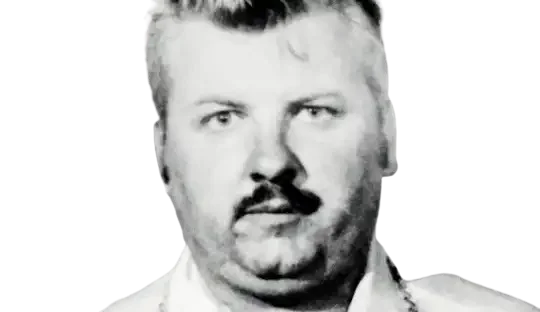He was the smiling face every child loved, the cheerful “Pogo the Clown” who performed at community parties and charity events. But behind that painted grin hid one of America’s most sadistic serial killers, John Wayne Gacy, a man whose crimes would haunt the nation for generations.
Between 1972 and 1978, Gacy lived a horrifying double life, a respected businessman by day, a cold-blooded murderer by night. When investigators finally uncovered the gruesome secrets buried beneath his suburban Chicago home, the world discovered a nightmare that blurred the line between charm and cruelty.
Even decades later, the Killer Clown case continues to terrify and fascinate the world, a chilling reminder that evil can hide behind the most ordinary smiles. From his twisted psychology to the shocking police discoveries, the John Wayne Gacy story remains one of the darkest chapters in true crime history.
Early Life and Background
From the very beginning, John Wayne Gacy’s story was shaped by conflict, illusion, and hidden darkness.
Birth and Family
Gacy was born on March 17, 1942, in Chicago, Illinois. He was the second of three children and the only son of John Stanley Gacy (an auto-repair machinist and WWI veteran) and Marion Elaine Robison (a homemaker). The family was Catholic, with Polish and Danish ancestry.
Childhood Struggles and Trauma
From a young age, Gacy faced a turbulent family environment. His father was frequently abusive, verbally and physically, and often used alcohol. Gacy’s father belittled him, calling him “dumb” or “stupid,” and compared him unfavorably to his sisters.
Gacy, by contrast, was described as overweight, unathletic, and prone to blackouts and illness, including a diagnosed heart condition and a childhood head injury after being struck on the head by a swing.
Gacy’s relationship with his father was especially difficult. His father expected him to be a “man’s man,” yet Gacy didn’t fit that mold. He sought approval, but rarely earned it, creating the first cracks in his identity.
Early Behavior and Education
Gacy attended Catholic school and then public school after a family move. He showed little athletic ability and few close friends. He was socially awkward, experiences that would feed into his later persona of outward normalcy, hiding inner turmoil.
At age 18 (in 1960), he dropped out of high school. Briefly, he moved away to Las Vegas, working as a mortuary attendant, a job where he observed embalming and later revealed he had engaged in necrophilic acts.
Despite not finishing high school, Gacy later enrolled in Northwestern Business College in Chicago and graduated in 1963.
Early Career and Public Persona
Following his business-college graduation, Gacy accepted a management-trainee position with a shoe company, then married Marlynn Myers in 1964 and moved to Waterloo, Iowa.
He worked managing Kentucky Fried Chicken franchises owned by his father-in-law, and became involved in community organizations like the Jaycees and local Democratic politics.
During this period, he cultivated a respectable image: businessman, civic-minded volunteer, and friendly neighbor, a façade that would later enable his dark secret life.
The Double Life: Clown by Day, Killer by Night
The story of John Wayne Gacy illustrates one of the most chilling examples of a criminal living a perfectly orchestrated double life, a respected community figure by day, and a ruthless serial killer by night. His case underscores how outward appearances can mask unimaginable evil, making it a stark reminder in the world of true crime.
Community Man & Clown Persona
Gacy cultivated a wide-ranging public persona that allowed him to move almost unnoticed in his suburban community of Norwood Park Township, a suburb of Chicago:
- He ran his contracting business (PDM Contractors), employed youth, and was politically active.
- He volunteered at local fundraisers, merited civic recognition, and was involved in children’s events.
- Crucially, he adopted a clown persona: he created characters such as “Pogo the Clown” (and to a lesser extent “Patches the Clown”) and performed at hospitals, birthday parties, charity functions, and community parades.
- Gacy himself described the clowning as a way to “let yourself go and act a fool”, saying it relaxed him.
This layered identity, the friendly entertainer, the businessman, the volunteer, gave him a veneer of unsuspected normalcy. This normalcy proved key to his ability to lure victims and evade suspicion.
Hidden Crimes Behind the Mask
Beneath the mask of social respectability and jovial performance, Gacy’s darker side evolved and escalated into violence:
- From 1972 to 1978, he sexually assaulted, tortured, and murdered at least 33 males, young men, and teenage boys.
- Many victims were lured to his home under the pretext of employment with his company or parties; others were tricked with handcuffs, alcohol, or drugs.
- A key facet: though Gacy performed as a clown publicly, he did not kill his victims while dressed as Pogo; rather, the clown persona was a tool of his public façade, not his crime scene disguise.
- Investigators discovered that Gacy buried dozens of bodies beneath his home’s crawl space and disposed of others in nearby rivers.
Why the Dichotomy Mattered
This two-pronged existence,well-liked citizen and secret murderer, proved to be a powerful enabler:
- The clown and community volunteer identity helped him gain trust among neighbors, young men seeking work, and community organizations.
- His outward respectability provided a shield against suspicion; many assumed a clown at children’s events couldn’t possibly be capable of grave crimes.
- The dual life underscores how serial offenders can embed themselves in a community, leveraging social capital to commit crimes undetected for years.
The Horrifying Crimes and Victims of John Wayne Gacy
Between 1972 and 1978, John Wayne Gacy carried out one of the most chilling serial murder sprees in U.S. history. This case left deep scars in the Chicago area and continues to intrigue true crime audiences worldwide.
Modus Operandi: How the Killer Operated
Gacy’s pattern of crime was marked by the manipulation, assault, and murder of young men and teenage boys. According to reliable sources:
- His first known victim was 16-year-old Timothy McCoy, whom he lured from a Greyhound bus terminal in Chicago in January 1972.
- Gacy typically enticed victims with the promise of work for his construction company (PDM Contractors) or other jobs, or simply by offering them a ride or a drink.
- Once at his suburban Norwood Park home near Chicago, he would employ tricks such as handcuffs, “magic tricks,” alcohol, or drugs to gain control of the victim.
- The killings were usually by strangulation or asphyxiation. Gacy buried the bulk of his victims in the crawl space beneath his house; some were dumped in nearby rivers when he ran out of space.
Victim Count and Recovery of Bodies
- Gacy was convicted of 33 murder counts involving young men and teenage boys.
- At the time of his arrest, investigators discovered 29 bodies in the crawl space of his home, and 4 additional bodies in the nearby Des Plaines River.
- Some victims remained unidentified for decades. For example, in October 2021, authorities announced the identification of victim #5 as Francis Wayne Alexander (killed somewhere between 1976 and 77) using genetic genealogy.
Sample Victims and Notable Cases
A few of the victims stand out due to the circumstances or their identification:
- Timothy McCoy (16) – the first known victim in 1972.
- John Butkovich (17-18) – a young employee of Gacy’s who vanished after complaining about pay; later found in Gacy’s garage area.
- Randy Reffett (15) and Sam Stapleton (14) – abducted together on May 14, 1976, and later found in the crawl space.
Impact and Legacy of the Crimes
- The horror of the “house of horrors” in Gacy’s home shocked the nation. It became a symbol of how evil can hide behind a friendly façade, reinforced by his clown persona and community involvement.
- The long-term identification of victims through DNA and genealogy highlights enduring efforts toward justice and remembrance for the young lives lost.
Investigation and Arrest of John Wayne Gacy
The downfall of John Wayne Gacy, one of America’s most infamous serial killers, began with the disappearance of a single teenager, Robert Piest, in December 1978. What started as a missing person case soon uncovered one of the most chilling crime scenes in U.S. history.
The Disappearance That Sparked Suspicion
On December 11, 1978, 15-year-old Robert Piest, a high school student from Des Plaines, Illinois, went missing after telling his mother he was going to speak with a local contractor about a job. That contractor was John Wayne Gacy.
When Piest never returned home, his family immediately reported him missing, leading police straight to Gacy’s doorstep. Detectives found Gacy’s overly calm attitude suspicious. They began a closer look into his past, one that was far darker than anyone could have imagined.
Following the Evidence
Police surveillance of Gacy quickly revealed inconsistencies in his story. A search warrant was soon issued, allowing investigators to examine his house and vehicle. Inside, they found several disturbing items, including identification cards and personal belongings that didn’t belong to Gacy.
Although not enough to arrest him right away, these discoveries kept Gacy under close watch. As the days passed, his erratic behavior and sleepless nights raised even more alarms.
The Horrific Discovery
A second search warrant changed everything. When investigators returned to Gacy’s home, they began digging in the crawl space beneath his house. They unearthed the remains of multiple young men. The shocking discovery revealed a gruesome truth: Gacy had been luring victims to his home for years, killing them, and burying their bodies in the crawl space.
Further searches found even more victims buried on his property and dumped in nearby rivers. In total, 33 young men and boys were confirmed as his victims, making it one of the most horrifying crime cases in American history.
Arrest and Aftermath
On December 21, 1978, John Wayne Gacy was arrested and charged with multiple counts of murder. The evidence gathered from his home and the testimonies of survivors left no doubt about his guilt.
In 1980, Gacy was convicted of 33 murders and sentenced to death. After spending years on death row, he was executed by lethal injection on May 10, 1994.
A Turning Point in Criminal Investigation
The investigation into Gacy’s crimes became a landmark case in U.S. law enforcement history. It showcased the importance of thorough police work, forensic science, and persistence, proving that even the most ordinary-looking person can hide unimaginable evil behind a friendly face.
Psychological Profile: What Made Gacy a Monster?
Understanding John Wayne Gacy’s crimes requires more than just recounting what he did; it means looking into why he became one of the most terrifying killers in American history. Behind the cheerful smile of a party clown lay a man battling deep psychological conflicts, unresolved trauma, and an overpowering need for control.
A Troubled Childhood That Shaped His Mind
Gacy’s disturbing behavior traces back to his early years in Chicago. He grew up in a strict household under an abusive, alcoholic father who frequently insulted and beat him. Despite trying hard to earn his father’s approval, Gacy was often called weak and worthless. These constant humiliations left him with deep emotional scars and a desperate craving for validation and power.
As a child, Gacy also suffered from health issues, including fainting spells and a heart condition, which made him feel different and isolated from other kids. His difficult relationship with his father and social rejection may have fueled the anger and resentment that later surfaced in his crimes.
The Mask of Normalcy
One of the most chilling aspects of Gacy’s personality was his ability to appear completely normal. He was well-liked in his community, ran a successful contracting business, and even performed as “Pogo the Clown” at children’s parties. Psychologists later described this as “masking behavior”, a way for Gacy to hide his darker impulses behind a socially acceptable persona.
This duality, cheerful clown by day, predator by night, became a symbol of how dangerous hidden psychopathy can be when it goes unnoticed.
The Need for Power and Control
At the core of Gacy’s crimes was an intense need to dominate and control others. His victims were often young, vulnerable men who trusted him or sought work. Gacy manipulated this trust to gain power over them, physically, psychologically, and emotionally.
Experts have noted that this pattern of control is common among psychopaths and sexual sadists. For Gacy, the act of killing wasn’t just violence; it was a twisted assertion of authority, a way to feel powerful after years of feeling powerless in his own life.
Diagnoses and Personality Traits
During his trial, multiple psychological evaluations were conducted. While his defense team claimed he had dissociative identity disorder, the prosecution’s experts described him as a psychopath, someone fully aware of his actions but devoid of empathy or remorse.
He showed classic traits of Antisocial Personality Disorder, including:
- Superficial charm and manipulation
- Lack of empathy or guilt
- Deceptive behavior
- Grandiose sense of self-importance
Gacy’s chilling statement, “Clowns can get away with murder”, revealed just how detached he was from morality and human emotion.
The Making of a Monster
John Wayne Gacy wasn’t born a killer; he was shaped by years of abuse, emotional neglect, and deep-seated resentment. But what made him truly terrifying was his ability to blend in with normal society, fooling friends, neighbors, and even law enforcement for years.
His case continues to be studied by criminal psychologists as a haunting reminder of how psychopathy can hide behind charm, success, and a smile, until the mask finally slips.
8. Media Coverage and Cultural Impact
The case of John Wayne Gacy dramatically changed how society views true crime and popular culture. Here’s how the media coverage and cultural response unfolded:
How the Media Shaped the “Killer Clown” Image
The media played a central role in turning Gacy into the icon known as the “Killer Clown.” He had performed as “Pogo the Clown” for children’s parties and local events, and the press highlighted this contrast between entertainer and murderer.
This dual identity – one face for the public, another private – became a sensational narrative: a trusted neighbor by day, a serial killer by night.
Over time, the image of a clown mask hiding evil seeped into the public consciousness. The psychologist quoted in A&E’s coverage noted that Gacy’s crimes “cemented” the idea of clowns as potentially menacing figures.
Media outlets often emphasised his clown persona over deeper issues (such as victim profiles or systemic failures), which contributed to a popular myth: the smiling clown turned monster. While effective for headlines, the simplification sometimes overshadowed the victims’ stories.
Documentaries, Movies, and Books Inspired by His Crimes
Gacy’s story has inspired a wide range of true-crime media: documentaries, films, books, and television series. For example:
- The series Devil in Disguise: John Wayne Gacy (2025) on Peacock dramatises his life, crimes, and the investigation.
- The film Gacy (2003) and other adaptations trace his crimes and have helped keep the story alive in pop culture.
- Books and academic articles analyze how his case affected criminology, public safety, and media representation. For instance, one article reviews how the “killer clown” trope evolved as a result of his notoriety.
This media coverage both educates and entertains, but it also raises questions about how true crime is consumed: balancing respect for victims with public interest.
Public Fear and Fascination with the Case
The Gacy case stirred both fear and fascination. The sheer scale of his murders, the betrayal of trust, and the hidden nature of his crimes shook communities. It changed how people viewed safety, especially among youth.
His case also contributed to broader moral panics in the late 1970s and 1980s, including fears of missing children and hidden predators.
Yet fascination remains strong: fans of true crime are drawn to the complexity of his double life, the investigation, and how the “monster next door” theme plays out. This fascination underpins the ongoing interest in documentaries, podcasts, and books.
10. Conclusion: Lessons from the Killer Clown Case
The Gacy story offers powerful lessons for society, investigators, and true crime communities alike.
What Society Learned from the Gacy Case
- The case demonstrated that a dangerous individual can blend into a community, leverage trust, and hide evil behind a façade of normalcy.
- It reinforced the importance of vigilance, especially when individuals target vulnerable people under the guise of employment or help.
- Investigatively, it highlighted the need for inter-agency collaboration, improved missing-person reporting, and the use of forensic methods to uncover hidden crime scenes.
How It Changed Crime Investigation and Public Awareness
Following Gacy’s exposure, law enforcement and criminology emphasised new strategies: early intervention in missing-person cases, attention to offender patterns, and profiling of behaviour that transcends “just one incident”. His case became a teaching point in forensic psychology, victim support, and community safety education.
Public awareness also grew: parents, youth organisations, and community groups began discussing the risk of trusting appearances and the importance of boundaries, particularly with adults offering jobs or promises without transparency.
Encouraging Responsible Fascination with True Crime Stories
While true crime content can engage and educate, it comes with responsibilities:
- Focus on victims and survivors, not only the perpetrator.
- Avoid glamorising or sensationalising the crime, especially when a clown persona or other dramatic image dominates awareness.
- Use true crime interest as a tool for learning and prevention, not mere entertainment.
- The Gacy story remains relevant not because readers enjoy horror, but because the lessons about trust, deception, and safety are timeless.
FAQs
How many people did John Wayne Gacy kill?
John Wayne Gacy was convicted of 33 murders of young men and teenage boys between 1972 and 1978 in the Chicago area. Most of his victims were buried in the crawl space beneath his home, while others were dumped in nearby rivers.
How did John Wayne Gacy die?
Gacy was executed by lethal injection on May 10, 1994, at the Stateville Correctional Center in Illinois. He spent 14 years on death row before his execution.
Who is John Wayne Gacy?
John Wayne Gacy was an American serial killer and sex offender from Chicago, Illinois. Known as the “Killer Clown,” he lived a double life, working as a contractor and community volunteer while secretly murdering 33 victims.
What did John Wayne Gacy do?
Gacy lured young men and boys to his home with promises of work or friendship, then sexually assaulted and murdered them. His crimes shocked the world for their brutality and his ability to hide them behind a façade of normalcy.
Where did John Wayne Gacy live?
Gacy lived at 8213 West Summerdale Avenue in Norwood Park Township, Illinois, a suburb of Chicago. This house became infamous after police discovered the bodies of 29 victims buried beneath it.
Why was John Wayne Gacy called the “Killer Clown”?
He earned the nickname “Killer Clown” because he performed at local events as “Pogo the Clown” and “Patches the Clown.” The contrast between his cheerful public image and his horrific crimes made the name unforgettable.
How many people did John Wayne Gacy kill?
In total, 33 known victims were linked to Gacy’s crimes. However, investigators have long speculated that the real number could be higher.
Where is John Wayne Gacy’s house today?
The original Gacy home on 8213 West Summerdale Avenue was demolished in 1979. A new house was later built on the same lot, but it bears a different address to distance it from the property’s dark history.
Are there any John Wayne Gacy documentaries?
Yes, several documentaries and series explore Gacy’s life and crimes, including:
- “Conversations with a Killer: The John Wayne Gacy Tapes” (Netflix, 2022)
- “Devil in Disguise: John Wayne Gacy” (Peacock, 2021)
- “The John Wayne Gacy Murders: Life and Death in Chicago” (various platforms)
These productions provide interviews, crime scene evidence, and psychological insights into one of America’s most notorious serial killers.
Also Read: Everything We Know About Mike Wolfe Passion Project









This was beautiful Admin. Thank you for your reflections.
Nice post. I learn something totally new and challenging on websites
Hi there to all, for the reason that I am genuinely keen of reading this website’s post to be updated on a regular basis. It carries pleasant stuff.
Nice post. I learn something totally new and challenging on websites
I appreciate you sharing this blog post. Thanks Again. Cool.